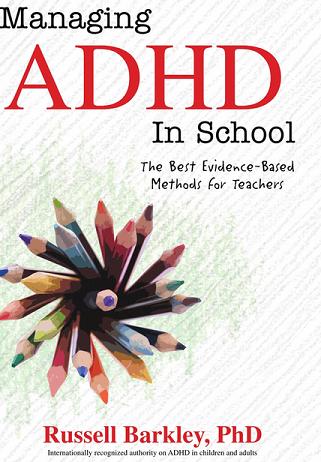
Dr. Russell Barkley, internationally respected expert on ADHD, draws on his 40 years of clinical work with thousands of students, teachers and schools to create a definitive resource for the most effective methods in overcoming impairments for children and teens with ADHD.
Managing ADHD in School读后感1.外化信息:externalize information
让学生公开口头陈述规则计划表现和承诺,或者录音的方式记录下来
2.外部表示或消除时间上的空白Externally represent or remove gaps in time
外化时间表示,减少或消除时间干扰因素,细化时间和内容分配,适当给予即时反馈和奖励。
3.外化动机externalize motivation
目标驱动行为goal-driven behavior
抱怨他们缺乏动力drive ,意志品质willpower 和自律self-discipline 解决不了问题
在期望的工作或行为的背景下,在绩效点安排人为的创造外部激励源的手段。提供必要的人为奖励provide artificial rewards
4.执行功能与自我调节executive function and self-regulation
情境选择,情境修改,注意力控制或重定向,重评,反应修正或抑制。
Situation selection, situation modification, attention control/redirection, appraisal, response modification/suprression.
也有建议两周能训练自律的规律的体育锻炼和任务练习
5.制定问题解决手册make problem-solving manual
make solving problems manual work and not just mental work.
做解决问题的手工工作,而不仅仅只是脑力劳动。思考~分解~
6.自然环境中的绩效干预intervene at the point of performance in natural settings
问题存在的自然环境中去干预
7.作为慢性过程探讨as a chronic condition
Classroom management considerations
1.decrease workload, have them sit near the teaching area. Give out weekly homework assignment.
2.allow restlessness, give frequent but brief physical exercise breaks.
3.get color binders, color-coding texts. Highlight key points down.
4.participatory teaching. Practice skills on the computer.
5.discourage impulsive answers. Alternate low-appeal with high-appeal activities.
6.be more animated, theatrical and dramatic when we teach.
7.touch a child lightly to get undivided attention.
8.present work goals. Give short assignments, clear goals and frequent quizzes.
9.require continuous note taking. Peer tutoring.
Increase rewards for good behavior
1.increase use of verbal praise, approval, appreciation. Be a 1-minute manager.
2.use a token system or point system to organize privileges and prices. Allow ss access to the rewards of the class often.
Daily Behavior Report Cards and Behavior Contracts
1.Creating Daily Behavior Report Cards
Valued and reviewed both at school and home.
2.the report card involves both social conduct (shares, plays well with peers, follows rules) and academic performance (completes math or reading assignments).tangible rewards and token programs. think aloud-think ahead
3. behavioral contracting , set academic and behavioral goals.
Externalize information and time.
1.make rules obvious and in physical forms. Use a three-sided stop sign, place color-coded card sets on the students desks.
2.Present the command in a businesslike tone of voice. Have eye contact with the children to get them focused. Reduce all the distractions before giving the command.
3.Make time real.
Improve self-awareness
1.have the child record his work productivity on a daily chart or graph.
2.Develop a simpler cueing system to let children know they may be behaving inappropriately.
3.use Nonverbal confidential cues to signal them to stop and self-monitor.
Transition planning
1.Before starting a new activity, review a few rules the child needs to obey.
2.child repeats these rules out loud.
Discipline
1.use mild, private, brief, direct reprimands. Direct, personalized instructions.
2.immediacy is the key. What makes punishment work is not so much its severity, the degree of pain or unpleasantness afflicted, but the speed with which its implemented following some misbehavior.
3.Moray essays, response cost, establish a quiet chill out location, in-school suspension.
Other tips
1.keep a set of books at home.
2.use typing and keyboard skills for written assignment.
3.digitally recorded lectures.
4.bucks for Bs
5.engage in note taking.
6.peer tutoring
7.parent-teacher review meetings
8.schedule harder classes in late morning or early afternoon hours.
9.permit teens to listen to music on earphones
10.give teens written a syllabus as handouts
11.require teens to attend after-school help sessions
Medications Used to Manage ADHD
1.Stimulants and Nonstimulants
work by increasing the amount of two (or more) chemicals in the brain known as neurotransmitters.The two neurotransmitters are dopamine and norepinephrine. recent studies show that children who have taken these medications (especially the stimulants) are likely to have brain development that is closer to normal than children with ADHD
2.Types of Stimulants and Actions
Two basic types of stimulants are currently marketed in the United States: methylphenidate (MPH) and amphetamine (AMP).
3.The Five Stimulant Delivery Systems
the 5 Ps-pills, pumps, pellets, patches, and pro-drug.
4.Side Effects of Stimulants
Insomnia, or trouble falling asleep.
•Loss of appetite, especially for the midday meal
•Weight loss
•Headaches.
•Nausea, upset stomach, or stomachache.
•Anxiety
*Irritability, or being easily upset, angered, or prone to outbursts *Motor tics
•Increased muscle tension
Atomoxetine-A Nonstimulant
ATX Side Effects:
•Nausea or vomiting
•Dry mouth
•Dizziness or light-headedness
•Constipation
•Sweating
•Decreased libido (sex drive) or erectile dysfunction
•Sweating
•Insomnia (far less common than with the stimulants)
•Irritability
Antihypertensive Drugs(last choice )